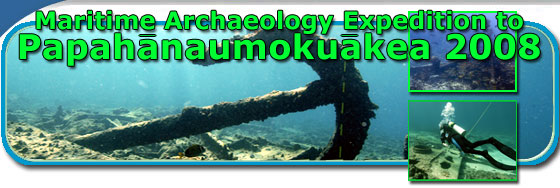Error processing SSI file
|
Mission Blog: August 13, 2008
The Elements of Discovery
By Kelly Gleason, Maritime Archaeologist
Papahānaumokuākea Marine National Monument
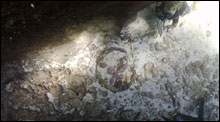 |
|
Overhead view of a trypot buried in the sand and filled with bricks, a
fastener, copper sheathing at the Gledstanes shipwreck site.
|
Today was a great day to be a maritime archaeologist! After conducting a systematic search based upon historical records, the team discovered what we are confident is the remains of the Gledstanes, a British whaler that wrecked in heavy seas on the reef at Kure Atoll in 1837. The team began the day where we left off yesterday: conducting towboard- and drift dive searches for the Gledstanes along the seaward side of the reef. While yesterday’s surveys revealed the spectacular corals and marine life abundant along the reef, no signs of shipwreck were found. Nevertheless, during this morning’s preparations for dive operations, the team felt upbeat and hopeful that, with the combination of fantastic weather, talented teammates, and careful preparation, we might have more luck in finding the remains of the elusive whaler. Sure enough, at the end of the first drift dive of the day, the team discovered a pile of iron ballast and some chain. The ballast led a trail into the dramatic spur-and-groove topography of the reef of Kure Atoll, where further artifacts were scattered as they wrecked in 1837. Four massive anchors, iron ballast, what appear to be two cannons and a trypot filled with bricks, copper sheathing and a fastening are all tucked into the dynamic grooves of the reef.
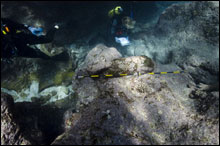 |
|
Divers document a cannon at the whaling shipwreck Gledstanes at Kure Atoll.
|
What we know, so far, of the story of the Gledstanes and her survivors is limited but adds to the important legacy of shipwreck survival stories at Kure Atoll. After the loss of their ship, the crew launched the ship’s small boats and made for the closest dry land—the small sandy island at Kure Atoll named Ocean Island. In a short time, the ship broke apart in the heavy surf. The crew salvaged what they could from their destroyed ship and set about fashioning a 38-foot vessel called the Deliverance.
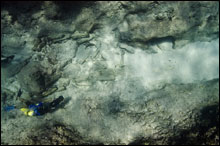 |
|
Diver films iron ballast scattered outside of the reef at Kure Atoll, near the shipwreck site.
|
Today’s find was a thrilling experience for the team. We begin each expedition with high hopes of new discovery and successful documentation, but there are so many unavoidable obstacles that can foil our attempts to accomplish all the goals we have set out for the voyage--bad weather, maintenance issues, and gear failure, to name just a few. Often, expectations are adjusted as the expedition is underway. We have been fortunate to have so many success factors fall into place. The weather, usually unpredictable and challenging in the Northwestern Hawaiian Islands (even at this time of year), has remained steady and calm. Conditions have allowed us to access areas of the reef where it is often too dangerous to work…just the kinds of places where ships meet their end. For years I have been coming up to Kure Atoll in hopes of searching for this particular shipwreck but have thus far been deterred by the weather and unworkable conditions. This year, the Gledstanes was revealed to us, and we couldn’t be more thrilled with the opportunity to share this wreck site and its story with the public. We began preliminary documentation of the site today and will continue taking measurements, photographs, and video footage of the shipwreck site tomorrow. We also hope to explore the area further to discover new parts of the shipwreck, since, like so many other sites in the Monument, the Gledstanes has truly become part of the environment in the last 170 years. Some heavy metal artifacts (such as the cannon) have been weathered and worn to the point that we are not entirely sure of what we are looking at. The trypot is buried deeply in the sand, almost as if it has been consumed by the reef itself. These are dramatic images and make the experience of encountering this shipwreck site so much more powerful. The Gledstanes is the fourth whaling ship discovered thus far in Papahanaumokuakea Marine National Monument, shedding further light on the major significance of nineteenth-century whaling heritage in this region.
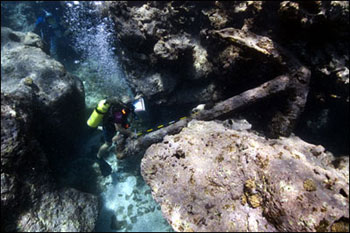 |
|
Diver investigates an anchor on the shipwreck site Gledstanes at Kure Atoll.
|
To ask us questions, you can email the team at: sanctuaries@noaa.gov
and we will answer your questions within the blog, or in a live
internet broadcast later in the cruise. Again, stay tuned for details.
|

